Episode #8: How B2B Companies can Leverage Case Studies to Generate Leads
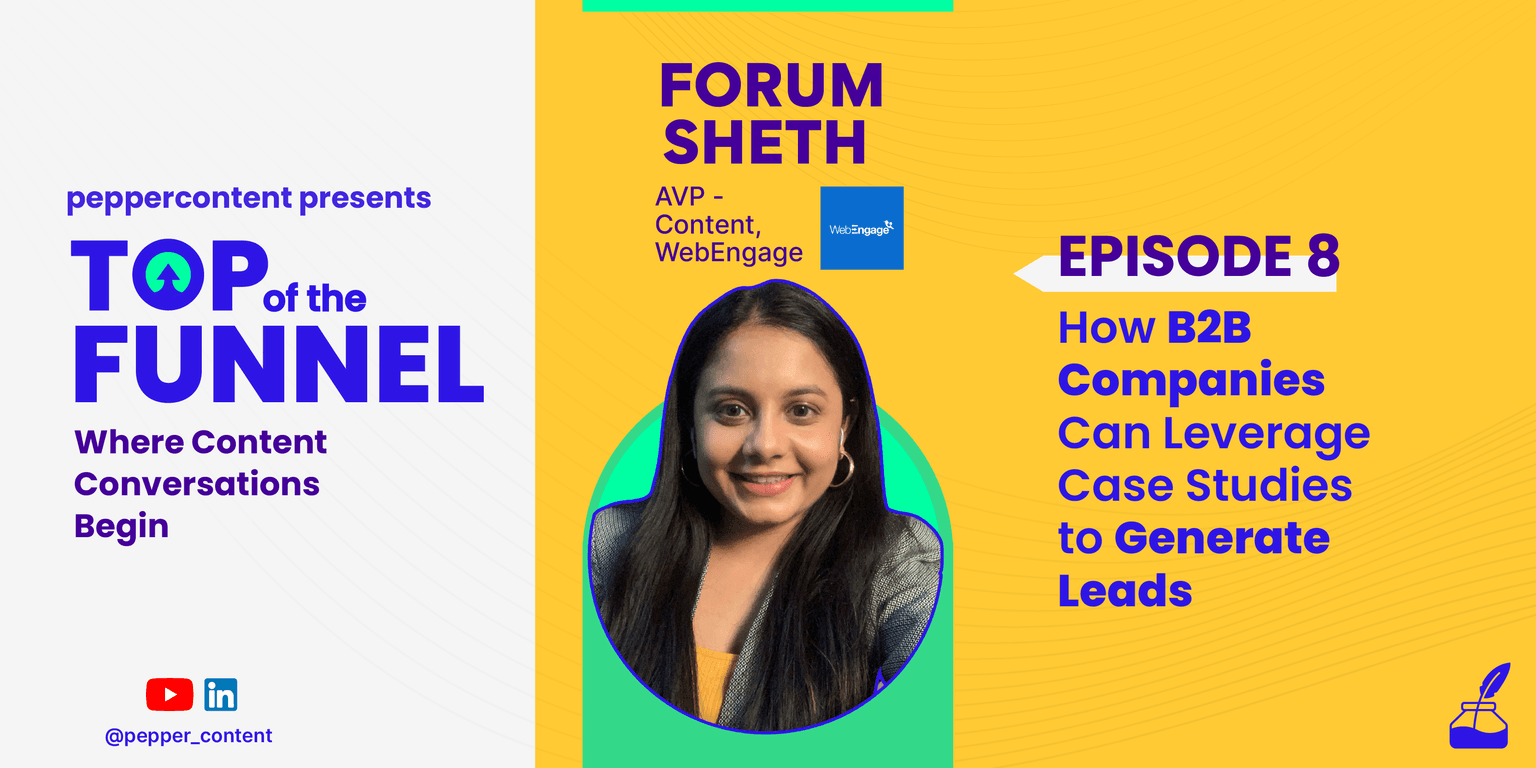
Every brand has a specific form of content that they specialize in. This content has the potential to be a consistent lead magnet for prospects. It is up to the brand to turn that content into a desirable format and distribute them across channels to reach their target audience. Natasha Puri, Content Marketing Lead at Pepper Content, talks to Forum Seth, Assistant Vice President of Web Engage. Web Engage specializes in curating customized content for industry-specific queries and using case studies to validate their arguments.
Natasha Puri: Hello everyone. Welcome to Top of the Funnel, the series where conversations about content begin. I am Natasha Puri, Content Marketing Lead at Pepper Content. Our guest today is Forum Sheth, the Assistant Vice President of Web Engage, a platform that helps companies craft campaigns in seconds using their product innovations like ‘journey designer.’ This chat is going to be very informative and value-loaded, as Forum will talk us through her career as a content marketer, the creation and distribution strategies at Web Engage, and how to measure the pitfalls and successes of content marketing.
Would you tell us about your journey so far, the kind of roles that you have dabbled in, and the kind of work that you have done? What is your current role at Web Engage? What does a typical day for you at Web Engage look like?
Forum Sheth: I have always been a lover of all things content, right from school. Initially, I did not have the privilege of studying in a full-fledged English medium school. I had to travel a few kilometers to a different state altogether to study. This motivated me to have a lot of conversations in school. Something about conversations has always stayed with me. You get to learn so much from conversations. I started journaling on my conversations. And, that is how my first job came into the picture.
I started off with Netcore as a copywriter, where I moved on to be a content writer, and so on and so forth. Soon, I did everything that a content person would do and would not do as well. I spent a couple of years at Netcore. Then, I took a break from the corporate side and I got back to meeting more people as a freelancer, hosting programs for companies like Ford & Motors, Cipla, and Crossword Bookstores. I was also interviewing people.
In a nutshell, I was doing a lot of freelancing in the content field itself. This is how I got back into the B2B SaaS arena, where I joined Web Engage as a content marketer. After one year into the role, I got promoted to lead the content marketing team at Web Engage, where I also built the team from scratch. Now, I lead and oversee the content marketing team, as a whole, at Web Engage.
Natasha Puri: How is your team structure? What do you do in terms of leading the team?
Forum Sheth: When you build a team from scratch, you tend to see it as two kinds of people-writers and marketers. All writers are not marketers. We have a set of people, who just do the writing. And, we have a set of people, who write, but also largely take care of the distribution part of the content, the content marketing side of it.
One unique thing that you might not see in the B2B SaaS content marketing teams is that we have a dedicated case study team. They are also writers and marketers. But, there have been some people within the team, who have picked and chosen the case study team. They take care of everything, coordinating between house account managers, working with the customers, developing the story, and taking care of the designing, and publication part of it.
Then, we have an email marketing team, a social media team, and as I said, writing and a marketing team.
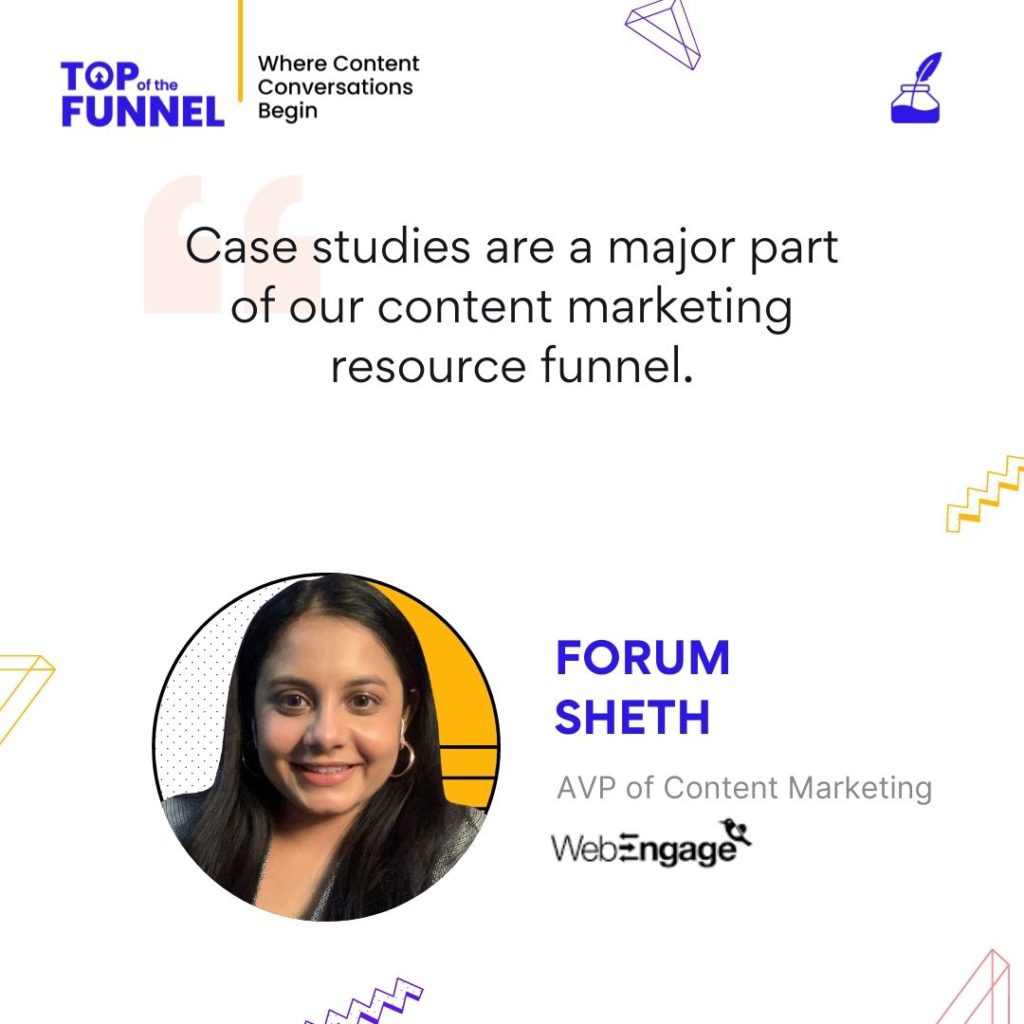
Natasha Puri: Case studies are a big pillar for you. I have spoken to a few people, but I have not heard of them talking specifically about case studies, having a full team, and putting so much emphasis on that. Of course, It is part of their funnel. They do generate case studies. If I were to ask you, what are some two, or three things key to your content marketing strategy at Web Engage?
Forum Sheth: In terms of resources, case studies are a major part of our content marketing resource funnel. Other than that, we try to develop a lot of ebooks. They are not the kind of ebooks we usually see in the B2B SaaS world. We are very specific in developing our ebook. If you look at our resources on the Web Engage website, you will see that a lot of these ebooks are published in master packs.
Now, the question arises as to what are these master packs? These master packs are a collection of about four to five different resources, inclusive of a guide to a certain kind of engagement, or guiding how to retain users, or maintaining a certain revenue. These are curated for specific industries, namely ed-tech, fintech, gaming, and so on. So, we are quite deep in producing content for specific industries, rather than getting into the generic world.
The third most important part of our strategy is newsletters. Of course, these are not direct content resources. But, you are developing copies as a part of your distribution efforts. We have laid a lot of focus on our email marketing, especially the newsletters. I send out these newsletters, twice a month. These are highly curated newsletters. We try to tell stories. These are the most sought-after content among our audience. People write back to us, telling us how much they loved those stories. These are unlike the usual SaaS newsletters that you see in the market.
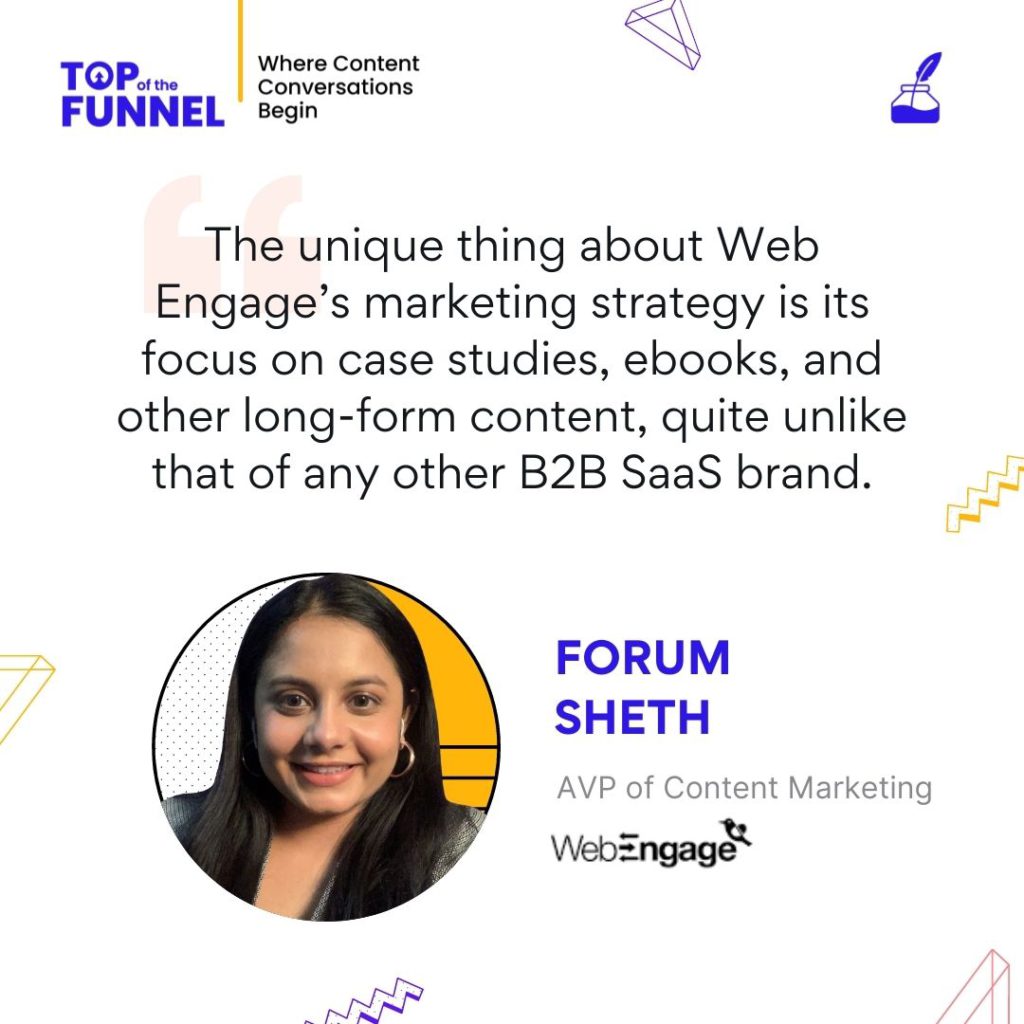
Natasha Puri: Can I say that your approach is more in terms of long-form content than short-form content, or would you say that short-form is more reserved for the newsletters, and you prefer going deeper in terms of your content in the ebooks, playbooks, etc?
Forum Sheth: I think I would go with what you said. While we do produce short-form content in terms of newsletters, short-form content would always be the repurposed version of our long-form content. We focus a lot more on long-form content. We intend to give out everything when we are writing long-form content. Let us say that I am writing a piece to develop a strategy to retain ed-tech users. I will make sure that it covers everything from step: A to step: Z. There will be nothing left. It will contain everything from how-tos and examples. You are right. We are a lot more focused on long-form content. Even our newsletters are quite long. They might start off with a story, some anecdotes, then resources, and some feel-good content in it as well. Long-form is something that we love doing at Web Engage.
Natasha Puri: Long-form is a heavily researched piece of content. Not everyone can get it right. The downside or the up-side of it is that there is so much content on the internet nowadays, that it feels like you are reading something that you have already read before. What are some of the things that brands and companies can do to create long-form content that actually makes a difference?
Forum Sheth: Do you want me to focus on a specific type of long-form content?
Natasha Puri: As you previously mentioned, we can talk about ebooks.
Forum Sheth: As you said, long-form content takes a lot of research. Compared to short-form content, long-form content does take a lot of time too. Our case studies are almost a dozen pages usually. Ebooks are another long-form content that we put out. It contains everything about a brand, how does the brand handle a particular case, and how its audience can use it. There is a kind of hand-holding that goes in our long-form content. This is what makes our content at Web Engage very unique.
There is no dearth of content in the SaaS world. In the last couple of years, people have rightfully understood the importance of content. People have accepted it in their way of life. We see brands producing dozens of talks every week. What really makes the audience stick to your content, especially from my experience is the ‘simple’ mantra. Keep things simple. Or, keep the data balance. Pack it with research.
If you are sticking to your own data like if I am writing an e-book on how to develop an effective in-app marketing strategy, I might not go to the Internet and look at ten different articles on what my competitors have posted. Maybe that will be 5% of my research strategy. But, 95% of my research strategy will rely on the data that the Web Engage dashboard provides. We have tons of clients using our in-app. So, why should I not look at our clients, study them, ask them questions, and then get the information out, and put it in a very understandable format through storytelling?
Another aspect of making long-form content reliable, engaging, and interesting is storytelling. When you write content, storytelling has to be a part of it. Whether it is SaaS or D2C, everything can be made interesting. SaaS does not have to be so boring. You can go beyond writing about the product and some steps. You can play around with the design and the way you write the content. You can have in-person, real-life examples because above all, your target audience is a human. They might be somebody who is receiving messages from another brand. As a user, they would receive notifications from several e-commerce brands. It is easy to digest interesting long-form content, and makes it relatable as well for them. After some paragraphs, you may want to give out some action items, something that keeps them hooked and makes them want to keep reading. It has to be something that keeps them aroused and something that they can implement. If you can hold their attention and give out something valuable, your long-form content is a success.
Natasha Puri: Would you like to add anything more on how to make B2B content interesting?
Forum Sheth: My Linkedin Bio says that ‘I make B2B and SaaS content more interesting.’ It has always been my primary motto. This is one of my favorite things to talk about. Since I covered some of it in my previous answer, I do not have much to add to it. When I started out around 6 years ago, I did not have exposure to the kind of resources that I enjoyed reading. I had to read about it, as my manager wanted me to. From my experience, I questioned that why can’t B2B brands be as fun and enjoyable as D2C brands. We look up to advertising companies like Ogilvy, and now we have people like you, who are working to make B2B and SaaS content more interesting.
The key to doing that is to put yourself in the shoes of whom you are writing for. I am writing for an eCommerce brand and I would want my target audience to be the CMO of another eCommerce brand, or the intern of that brand. So, what I need to ensure when developing content for an eCommerce brand is to really put myself in their shoes, and think of what their day would look like. What would be the resources that they are looking for? What are the questions and answers that they are looking for to solve their challenges?
I am sitting here as a B2B SaaS marketer. I would not really know what they want. I have to talk to them and really get to know them to write for them. Then, I would write as an eCommerce marketer to make that content easily digestible for my audience.
Natasha Puri: We have talked a lot about creation. Now, I would like to switch sides and pick your brains about the impact of your content, the ROI that most left-brained content creators do not want to think about, but are forced to think about now, as the scenario of content marketing is changing these days. How do you tackle these factors at Web Engage? Do you have any insights to share based on your experience? How do you track the success of your campaigns? How do you track your long-form campaigns?
Forum Sheth: If you are in content marketing, you cannot run away from tracking your content. You may want to make it less boring and more enjoyable for people. Ultimately, your goal is to bring business to your company. It is absolutely vital to do that. When it comes to case studies, our case studies are very easy to track, as they are dated. We keep a very close record of someone downloading our case studies, or any other downloadable content. Webinars are also tracked in terms of people viewing the webinar, the script, and so on. We have stuck to dated content. It makes tracking much easier, as to who is downloading it, whether they should move forward the funnel, engage with them more, or educate them more, or whether the product is right for them, or sometimes it may be the case of a consumer loving your content, but may not be the right audience to use your tool, or services. You will not invest your efforts, time, and energy to pull them further down the funnel. You will stick to just keeping them educated and delighted with your content.
We use our Web Engage dashboard, coupled with Google Analytics, and other Mar-tech tools to analyze the downloads and performance of our content. Our distribution channels track our newsletters and social media posts. One unique thing that our newsletters have is the option to reply back to me. And, I personally do engage with many of our users.
The good part is that we get responses to our newsletters. It has not been that great. The number varies by about ten people for every newsletter. They are not robots. They are also humans, sharing their experiences with me, and that is what is so great about this. It became a very special part of our community. You send out a newsletter to 60,000 to 70,000 people. And, some of them respond back to you. Somewhere along the way, they have made a connection with you and the brand. They are trusting you, and opening up to you via an email channel. We try to get these people deeper into our funnel. Most of these people convert really well. The sales cycle becomes seemingly faster for these people. That is how we go about it.
Natasha Puri: How important is defining the distribution strategy as a part of your content marketing strategy? What is the distribution strategy of Web Engage? Is it about working hard to create your own channels, or focusing on outreach? Is there a clearly defined strategy there?
Forum Sheth: If you want to get your content to the target audience, distribution is very crucial. It is better to have several distribution initiatives, right from your organic distribution to other forms of distribution, including paid and editorial. We have a content editorial in place at Web Engage. Our distribution team tracks the resources that are going out into the world. We take different steps, right from promoting a specific resource on social media on platforms like Medium, Quora, and other distribution platforms. Some of these platforms are handpicked and can display advertisements. We have our most beloved, newsletters. Newsletters are used to distribute a lot of our resources. We have a lot of other email campaigns that are run on a daily basis, where a very curated set of resources are distributed to another curated set of audiences.
We have a lot of industry-specific content. So, I would want to make sure that eCommerce resources go to the eCommerce section of users. An ed-tech resource will only be distributed to the ed-tech practitioners. We go deep into this when we frame our distribution strategy. The usual repurposing bit happens, where we share our long-form content as snackable content. They are promoted in the form of carousel posts on Instagram, or case studies are converted into slides and uploaded on the Slide Share app. We utilize Youtube, Instagram, and other social media platforms to convert long-form content into snackable content.
Natasha Puri: Let us talk about some of your favorite campaigns, that you would call successful. Tell us how you define success because, with content, it is slightly difficult to measure.
Forum Sheth: You can tell from our conversation till now, that case studies are my most favorite type of content. Fortunately, it is also one of our most successful resources.
Case studies, webinars, and e-books have been the biggest resources that we have had to track at Web Engage. Our case studies are long-form content. It is not just a story about a brand, with some other things thrown in, and sprinkling a bit of result here and there. It is very technical.
It could be something that you see in the medical industry about a patient, what were their issues, how did their treatment go, how was the solution formulated for resolving their issues, and what was the impact like.
If we do a case study for an eCommerce brand X, another brand Y can make use of something in that case study. How am I so confident about it? It is because of the responses that we have received and the impact that we have seen. On a daily basis, we see almost about a dozen downloads of our case studies, and the number only keeps increasing. We are also focusing on optimizing our case studies page. We keep a track of weekly results too. We monitor it so carefully that we reach a point, where we know what our customers want from us. Over the course of time, we have learned and unlearnt things and did stuff accordingly. It is the same for ebooks too. They are also dated, so it makes it easier for us to track.
Recently, we have also published a guide to Flash Sale campaigns. Every time any occasion like Black Friday rolls up, you will find all the B2B brands writing around how to conduct a Black Friday sale in blog format. We made an ebook, a guide to flash sale campaigns, which you can utilize throughout the year, whether you are in India celebrating Rakhi, or you are in the USA celebrating Halloween. There is certain content that is evergreen and can be consumed by people all over the world. And, there is some content, which is curated for specific industries. The impact also leads to something positive.
People write to our founders on Linkedin, or people reach out to me, telling how a piece of content helped them to accomplish something. These resources also come in handy for our sales team. There are certain areas, where you may not be able to measure an absolute impact in numbers, but you know the process. When a lead converts and you look back on the journeys, you will realize the resources that the sales team had shared with them. You get an overall impact of the real picture from such cases.
Natasha Puri: This was very interesting. What about other formats? Do you see yourself experimenting with videos or a podcast? What do you think of the role that these new formats play in the B2B SaaS space for a company like Web Engage?
Forum Sheth: We were dabbling in the video marketing space last year. This year, we have gone fully in, whether be it recording customer testimonials, or converting content pieces to helpful videos. Our podcasts are also available in video formats. Videos, podcasts, and webinars are equally important. They make up a very important part of our content marketing strategy.
Natasha Puri: What does the future of content marketing look like, especially in the B2B marketing space?
Forum Sheth: It is already a vast ocean, and it will only get bigger and bigger from here. A lot of companies have hinged on content marketing, because of the pandemic. If you look at the B2B SaaS arena from a couple of years back, only a few companies were relying on inbound marketing. Now, there are many companies, who are relying on inbound marketing.
Content is huge. It is not going anywhere. No matter AI, or any tech coming in, it is always going to be humans telling a story. It is going to be there forever. It is going to help businesses do better things, not only in terms of marketing but also will contribute to their growth.
Natasha Puri: We will end with a personal question. Tell us two things that you love about being a content marketer, and two things that you feel are the biggest challenges in your job.
Forum Sheth: There are more than two things that I love about being a content marketer, especially in the B2B SaaS space. Every day is going to be a challenge. We must do new things every day. My personal agenda is always to stay simple and original in whatever content we decide to produce. When you aspire to be original, it also demands a lot of brain work and creativity. It also eventually allows for a flow of a lot of happy hormones. It is very exciting to do. The second thing is that you get to impact a lot of lives. I believe a lot in human to human absorption, whether it is business, or consuming someone’s content. As I wake up every day, I feel excited that my team and I, will write something that will impact a bunch of people, if not the entire world. We can at least, make an impact on some people, who can make use of our content, and keep coming back to us. Then, my job is done.
Natasha Puri: And the challenges?
Forum Seth: One difficulty that I am facing, which I am not sure if other content marketing leads in the B2B SaaS space are also facing or not, is the fact that B2B spaces have never really considered the possibility of having in-house editors. Usually, the person leading the content marketing team becomes the bottleneck to ensure the finality, and fix the style to flex your brand. Sometimes, it becomes the bottom line. This is one of the challenges I face as a content marketer. In the B2B SaaS space, I would not say this is a challenge. But, we do lack meaningful in-house resources that help various emerging various geographies that are adopting the B2B practices in Latin America, the Middle East. Not every country is like the USA or India, which have been using the tools for years now. There is very little data given to our generations on how to develop these resources. It will be a challenge, as we will be the ones producing content for these places, the first wave of people setting the benchmark for these businesses.
Natasha Puri: That was not much of a challenge. You gave out the solution too. I really resonated with the editor part. They are the most underrated resources ever. They are the ones, who take the writing to the next level. I am sitting on the bottleneck, trying to ensure the finality, whether the messaging is right, and so on.
Forum Seth: I have realized this gap when I went to B2B SaaS business openings. There are rarely any talks of including an editor on the content team.
Natasha Puri: It is a lack of understanding of what value the editors bring to the table. It is not just in the B2B SaaS world. I have worked in publishing, on books. I have been a copyeditor for books. Other than writers who work with editors, there is rarely anyone, who understands the importance of this role.
Forum Seth: I agree, editors are really underrated.
Natasha Puri: I hope this changes soon. Most companies with a content plan must realize the importance of editors.
Forum Seth: I think it is also because people devalue themselves. We had an opening for an editor in our content team at Web Engage. People are often skeptical of not being respected in the B2B SaaS company. There is an overall perspective that needs to change.
Natasha Puri: Many editors also do not know how to edit a blog post or an ebook. It is not just changing some grammar. There is a general ecosystem that needs to change. It is slowly coming into place.
Forum Seth: The role and say that an editor has on the team is almost on par with someone, who leads the content team. Their reporting may not be on par with the leader. Nevertheless, their opinions and understanding of the brand cannot be undermined.
Natasha Puri: On that note, let us call it a day. Thank you for doing this with us.
Latest Blogs
Explore how Google’s 2025 AI search updates triggered ranking chaos. Learn actionable strategies to adapt your SEO for AI Overviews, zero-click searches, and SERP volatility. Stay ahead now.
Learn how to rank on AI search engines like ChatGPT, Perplexity, and Gemini by optimizing your content for authority, structure, and relevance. Stay ahead in AI-driven search with this strategic guide.
Explore the best healthcare SEO services for your medical practice. Improve online visibility and effectively reach more patients in need of your services.
Get your hands on the latest news!
Similar Posts
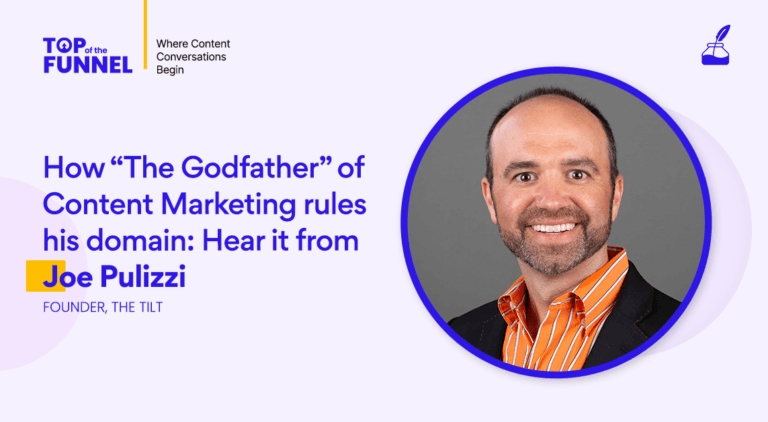
Expert Speak
18 mins read
Season 2 Episode #1 How “The Godfather” of Content Marketing Rules His Domain: Hear It From Joe Pulizzi
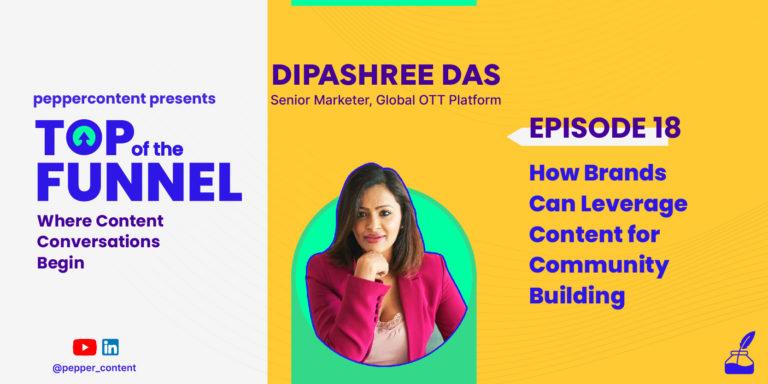
Expert Speak
16 mins read
Episode #18: How Brands Can Leverage Content for Community Building
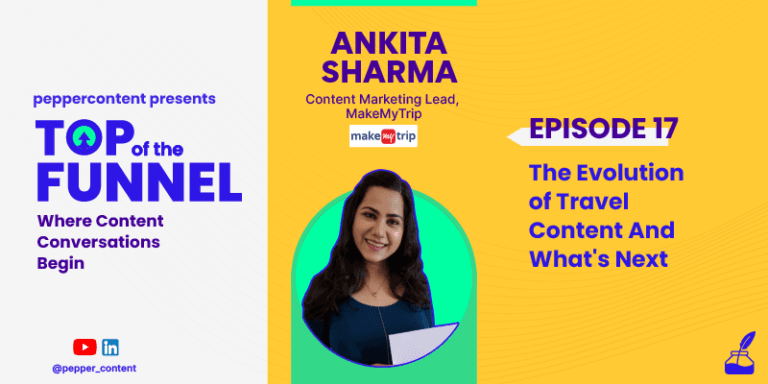
Expert Speak
11 mins read